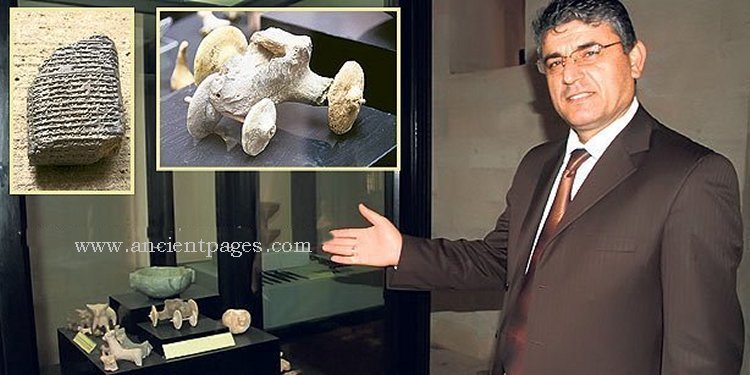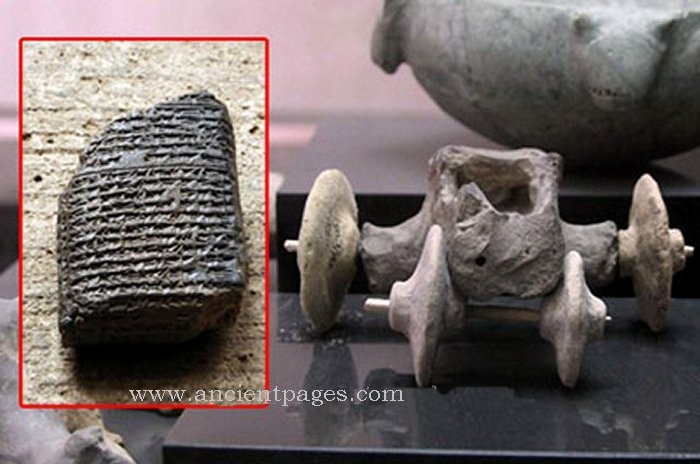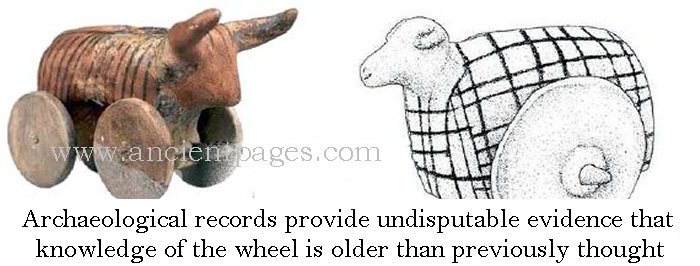World’s Oldest Toy Car – Could This 7500-Year-Old Discovery Be The Earliest Evidence Of The Wheel?
A. Sutherland - AncientPages.com - Today, parents buy their children electric car toys to play with, but the situation was somewhat different thousands of years ago.
Yet, this ancient discovery reveals our ancestors were aware of the wheel 7500 years ago!
A stone car with two axles and four wheels found during excavations in the Kiziltepe district of the southeastern province of Mardin, Turkey dates back to about 7500 years ago.
The world's earliest toy car (L) and title deed, unearthed at excavation sites in Mardin's Kiziltepe district, are on display at the Mardin Museum. (Photo: Cihan)
Archaeologist Mesut Alp said that the toy car, made out of stone, dates back to the late Stone Age and is thought to be 7,500 years old.
According to the Culture and Tourism Director of Mardin, Davut Beliktay, the car is like a copy of cars today. He also points out that the shape of this ancient toy resembles a tractor.
Findings in the area also included toy dolls and whistles made of stone. Interestingly, the whistles are still in working condition. It is believed they are 5,000 to 6,000 years old.
On display was also an ancient stone tablet inscribed with writing.
Following exhaustive historical analysis, the writing on the 5 centimeter stone, which was uncovered at an excavation site at the Girnavas Mound, 4 km from the historic district of Nusaybin -was deemed to be the content of an ancient title deed.
Beliktay said that the writing on the historic tablet had managed to remain intact over the years because of excellent preservation techniques. The script, he explained, had been scraped onto the clayish surface with a nail and then the tablet had been placed in a burner.
Archaeologist Alp explained that the title deed is 2,800 years old and pertains to selling a garden.
The content of the deed he added refers to a fruit garden and the fruit trees within, which are to be split between the owner's three sons. The deed refers to "Nabulu" which Alp explained was in fact the old name of the current Nusaybin. Beliktay has confirmed that comprehensive information on the two finds will be provided soon.
Still, the most fascinating item is the ancient car toy. Some have suggested it is not a car but rather a chariot. However, chariots usually have only two wheels and are pulled by an animal.
It would appear that the earliest variant of wagon models is represented by a combination of wheels and the draught animal. Altyn Depe, Turkmenistan - Credit: Hermitage Museum
Evidence of ancient knowledge of the wheel can be found in other time periods.
Rock engravings, the handful of wagon models, and the wagon depictions incised onto clay vessels are no longer our only proof for the use of wagons. New categories of evidence have enriched the archaeological record.
Left figure: Very little is known about this intriguing model save for the fact that it was found somewhere in Ukraine and that it can probably be dated to the period between 3950 and 3650 BC (CUCUTENI TRYPILLIA, Cat. no. U-102, 263). Right: figure: A two-wheeled cart made around the turn of the 3rd and 2nd millennium BC from Pakistan.
Marin Dinu wrote the first comprehensive overview of Copper Age wheel models in his study "Clay Models of Wheels Discovered in Copper Age Cultures of Old Europe Mid-Fifth Millenium B.C." Dinu pointed out that the use of wheeled vehicles could thus be dated much earlier than previously assumed.
Yet, archaeological record provides indisputable evidence that wheels were known across the greater part of Europe and Anatolia from the earlier 4th millennium BC onward.
However, nothing as astonishing as the ancient toy car kept at the Mardin Museum has ever been found.
So the question remains: Is this little ancient toy car perhaps the earliest evidence of the wheel?
Updated on September 15, 2023
Written by – A. Sutherland AncientPages.com Staff Writer
Copyright © AncientPages.com All rights reserved. This material may not be published, broadcast, rewritten or redistributed in whole or part without the express written permission of AncientPages.com
More From Ancient Pages
-
 2,000-Year-Old Buddhist Complex Unearthed In Northern Swat, Pakistan
Archaeology | Feb 20, 2021
2,000-Year-Old Buddhist Complex Unearthed In Northern Swat, Pakistan
Archaeology | Feb 20, 2021 -
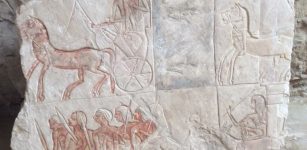 Unusual Scenes Painted On The Walls Inside Egyptian Tomb Of General Iwrkhy – Discovered
Archaeology | May 10, 2018
Unusual Scenes Painted On The Walls Inside Egyptian Tomb Of General Iwrkhy – Discovered
Archaeology | May 10, 2018 -
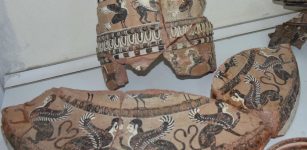 One Of A Kind 2,500-Year-Old Ritual Wash Basin Painted With Mythological Figures Discovered In The Ancient City Of Klazomenai
Archaeology | Oct 1, 2022
One Of A Kind 2,500-Year-Old Ritual Wash Basin Painted With Mythological Figures Discovered In The Ancient City Of Klazomenai
Archaeology | Oct 1, 2022 -
 3,000-Year-Old City Of Sillyon That Alexander The Great Failed To Conquer
Archaeology | Aug 31, 2020
3,000-Year-Old City Of Sillyon That Alexander The Great Failed To Conquer
Archaeology | Aug 31, 2020 -
 Oldest Known Human-Made Nanostructures Found In Ancient Artifacts In Tamil Nadu
Ancient Technology | Nov 23, 2020
Oldest Known Human-Made Nanostructures Found In Ancient Artifacts In Tamil Nadu
Ancient Technology | Nov 23, 2020 -
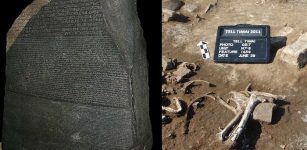 Archaeologists Dug For Evidence Of The Rosetta Stone’s Ancient Egyptian Rebellion – Here’s What They Found
Archaeology | Mar 7, 2023
Archaeologists Dug For Evidence Of The Rosetta Stone’s Ancient Egyptian Rebellion – Here’s What They Found
Archaeology | Mar 7, 2023 -
 Dance Was A Gift Of The Gods To Ancient Greeks
Featured Stories | Oct 4, 2021
Dance Was A Gift Of The Gods To Ancient Greeks
Featured Stories | Oct 4, 2021 -
 How Ancient Seascapes Shaped The Genetic Structure Of European Populations
Archaeology | May 20, 2022
How Ancient Seascapes Shaped The Genetic Structure Of European Populations
Archaeology | May 20, 2022 -
 Ancient City Empuries (Emporiae) With Best Greek Ruins Located Outside Of Greece
Featured Stories | Dec 29, 2022
Ancient City Empuries (Emporiae) With Best Greek Ruins Located Outside Of Greece
Featured Stories | Dec 29, 2022 -
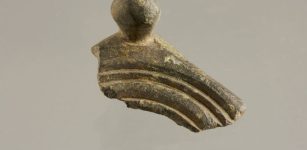 Piece Of Puzzling Roman Artifact Discovered In Belgium
Archaeology | Feb 16, 2023
Piece Of Puzzling Roman Artifact Discovered In Belgium
Archaeology | Feb 16, 2023 -
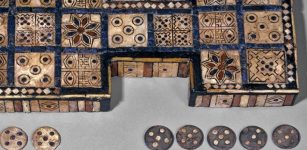 Royal Game Of Ur – One Of The Oldest Game Boards Discovered
Ancient History Facts | Feb 3, 2016
Royal Game Of Ur – One Of The Oldest Game Boards Discovered
Ancient History Facts | Feb 3, 2016 -
 Timing Of Easter Island’s Societal Collapse – Revisited
Archaeology | Feb 7, 2020
Timing Of Easter Island’s Societal Collapse – Revisited
Archaeology | Feb 7, 2020 -
 Hammer Of Thor – Great Loss Of Treasure That Protected Aesir Gods And Asgard
Featured Stories | Mar 14, 2018
Hammer Of Thor – Great Loss Of Treasure That Protected Aesir Gods And Asgard
Featured Stories | Mar 14, 2018 -
 Two Inca Measurement Systems Calculated By Polish Architect
Archaeology | Nov 4, 2020
Two Inca Measurement Systems Calculated By Polish Architect
Archaeology | Nov 4, 2020 -
 Ingvar Vittfarne: Viking Chieftain And His Tragic Expedition To The East
Featured Stories | Jul 21, 2022
Ingvar Vittfarne: Viking Chieftain And His Tragic Expedition To The East
Featured Stories | Jul 21, 2022 -
 Champ Dolent “Field Of Sorrow” Menhir – Largest Standing Stone Was Built By Fairies Ancient Bretons Said
Featured Stories | Oct 10, 2022
Champ Dolent “Field Of Sorrow” Menhir – Largest Standing Stone Was Built By Fairies Ancient Bretons Said
Featured Stories | Oct 10, 2022 -
 Coin Hoard Paints A Fascinating Picture Of Life Of Highland Clan Chief And His Household
Archaeology | Oct 13, 2023
Coin Hoard Paints A Fascinating Picture Of Life Of Highland Clan Chief And His Household
Archaeology | Oct 13, 2023 -
 The Maasai Legend Of Hero Lakalanga And His Ancient Footprints
African Mythology | Jul 12, 2019
The Maasai Legend Of Hero Lakalanga And His Ancient Footprints
African Mythology | Jul 12, 2019 -
 Glorious And Scary Orava Castle – Realms Of Nosferatu And A Historical Landmark Of Slovakia
Featured Stories | Jan 24, 2020
Glorious And Scary Orava Castle – Realms Of Nosferatu And A Historical Landmark Of Slovakia
Featured Stories | Jan 24, 2020 -
 Hundreds Of Highly Unusual Burial Gifts Found In Special Viking Chamber Belonging To Woman In Norway
Archaeology | Nov 26, 2020
Hundreds Of Highly Unusual Burial Gifts Found In Special Viking Chamber Belonging To Woman In Norway
Archaeology | Nov 26, 2020

